1936 FLOOD
from The Evening Guide Thursday March 12, 1936
With all the fury of a tropical hurricane, the tail of King Winter lashed out here early today and the flood waters of the Ganaraska River left in its wake terror and destruction.
It is practically impossible to estimate the damage in dollars and cents, but a conservative estimate will place the loss in the thousands.
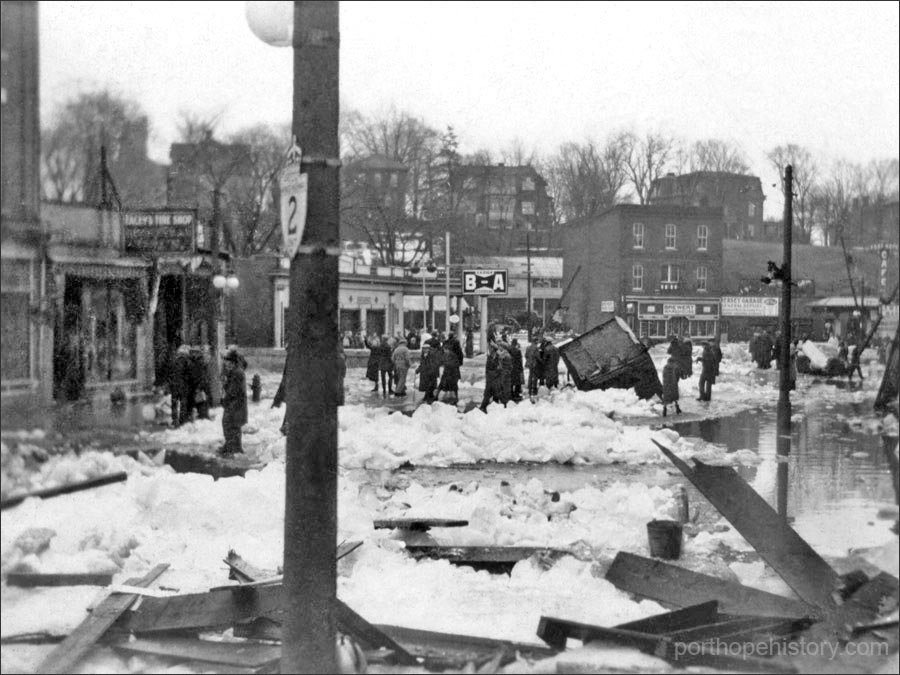
Walton Street bridge 1936
photo from Ken Lloyd
With a rush like thunder, huge cakes of ice, three and four feet thick and turbulent muddy waters surged through the entire business section from 1:30 this morning until early in the forenoon.
The Ganaraska, a peaceful rivulet in summer, surged beyond its banks and only after eight o'clock this morning was there a recession noticed. The tale of destruction cannot be completed or exact tabulation made at this time until waters have gone down and property owners and merchants have had a chince to inspect their damaged premises.
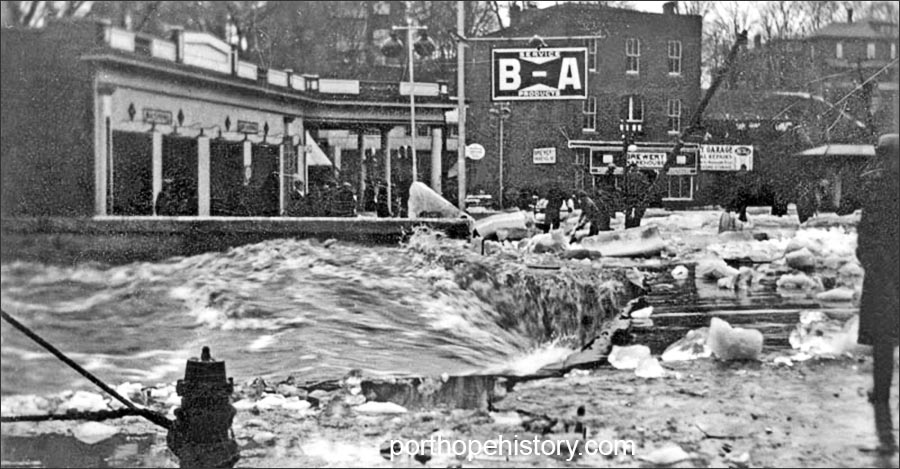
Walton Street bridge 1936
photo from Ken Lloyd
Up until noon on Wednesday, no grave fears were entertained and civic employees had taken preliminary precautions in blasting a channel through the three-foot ice from the Nicholson File plant, past the centre of the town to the harbour mouth.
At noon Wednesday, rain began to fall and before dark it had reached the proportion of the torrent. It continued until midnight and the peak of the flood came at 1:30 this morning. Terror pervaded throughout the town and scarcely a soul slept. From early in the evening merchants toiled to remove stock-in-trade, and then were forced to rapidly vacate or else ascend to upstairs quarters.
The flood workers were handicapped on account of the fact that the Hydro system was disrupted at midnight as several poles in the inundated area were cracked off like matchwood by the huge cakes of ice. Only one half of the front street was lighted and the lights in all the private homes were extinguished. Candles and lamps were resorted to while residents moved about in flooded homes. Total power service was not established up until noon.
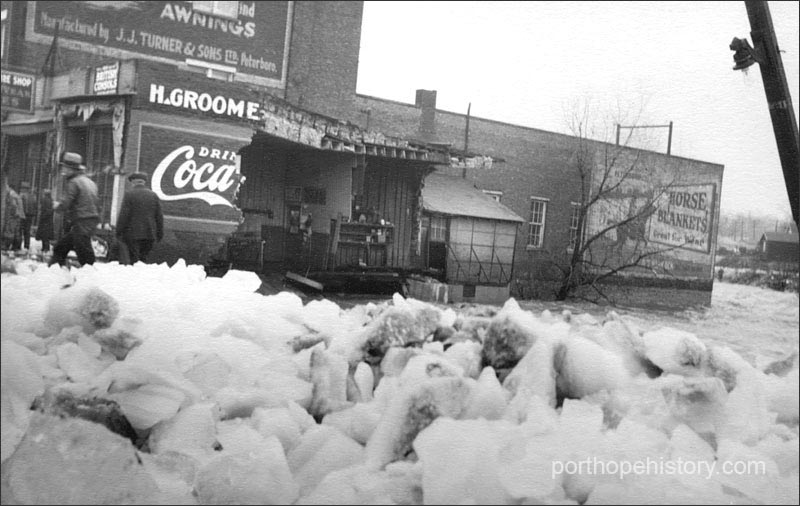
Walton Street bridge 1936
As a result of the largest and severest inundation which this town has experienced in its history, traffic was demobilized. Trains on the main lines of the Canadian Pacific and Canadian National were forced to move cautiously as waters from the low-lying district poured along the right-of-way. The Port Hope-Peterborough line was unable to be used at all, as tons of ice blocked the tracks in the centre of the town, and as well, the iron bridge over 100 feet long, at Beamish's Pond at the north end of the troubled area, was moved sideways to the extent of four feet.
At the same instant, the Nicholson File Company's dam went out with a terrific roar just a few feet away and by a turn of fate, none of the factory employees who had been toiling all through the midnight hours were on the structure. The substantial iron bridge was pried by the terrific jam of ice and as it commenced to move, Jack Moore, Hugh Fraser, Tom Long, Ed Fraser and Keith Larmer were standing on the end, and beat a hurried retreat. However, the double rails remained fast to the ties and although it twisted snakelike fashion, they managed to hold.
As soon as daylight came, there was revealed a gruesome picture which will cost the town authorities and citizens thousands of dollars.
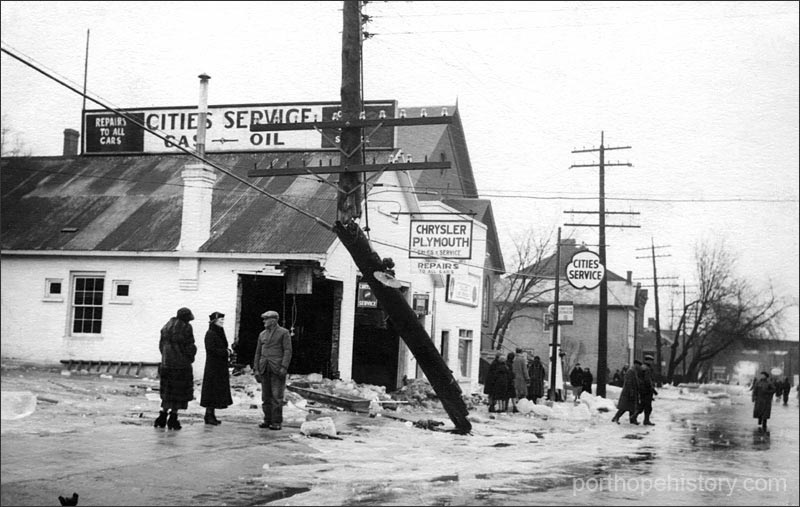
Mill Street at Walton Street 1936
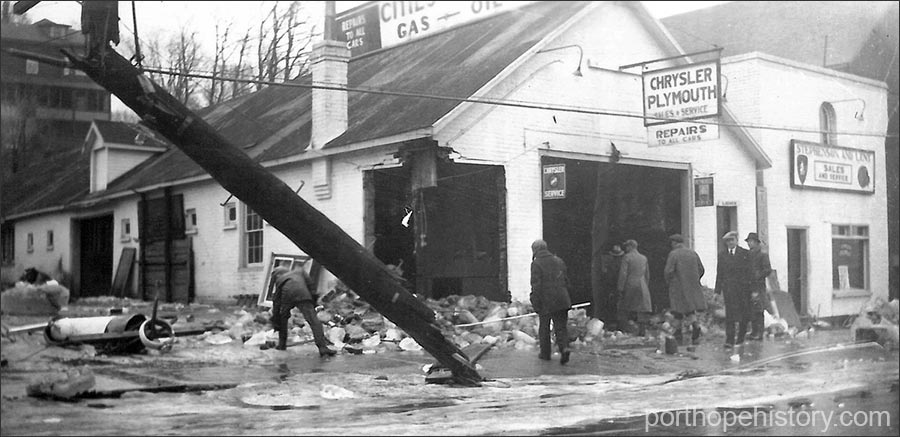
Within an hour or so, hundreds of citizens were in the downtown district inspecting the damage.
Fifteen homes on Cavan Street which parallels the Ganaraska were flooded with the water and residents were forced to flee. However, the occupants of a double house were trapped and firemen were called to free the inmates. Gerald Rowden and Russell Devine waded through waist high water to give the alarm and then the firefighters carried Mrs Devine and three children and Mrs Rowden and two children to safety. Firemen also rescued the Hutchison Family.
Both sides of the main bridge on No 2 highway were washed away but the main part of it remained firm. At the end of the bridge, a brick boot and shoe repair shop, owned by Miss Riordan and occupied by Horace Groome was swept down the river and into the lake. With it went most of the equipment valued at a considerable sum.
At the north end of the Canadian National bridge on Ontario Street, Roberts Brothers, butcher shop and all stock and trade was completely ruined. The heavy flow of ice knocked out the side of the building and the meats, cash register, cutter, scales, etc were sent downstream. From a rafter on the side remained the carcasses of three pigs suspended in the air.
The Nicholson File Company received a large share of muddy water and the ground floor was flooded to the extent of three or four feet.
Officials are unable to estimate the extent of the wrapped_stock which was damaged. However, great inconvenience was caused and in the other departments, the debris will be hosed out, machinery oiled and everything back in running order soon. About 250 men were unable to go to work this morning as well as the office staff.
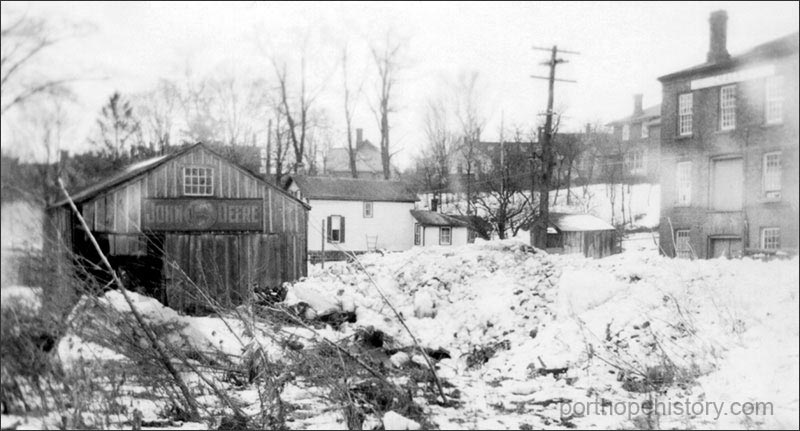
Ice piled up opposite Chalk's Carriage Works near the corner of Cavan and South Streets March 12, 1936
photo from Ken Lloyd
As the turbulent waters swept through the business section, scores of cellars of the stores completely filled. But the storekeepers, mindful of past experiences, had carried most of their goods to high and dry positions. Some of the stores which were flooded included: Doney and Giddy; Bank of Toronto; Geo T Hancock, hardware; Bert Broadbent's bakery; R S Brown's flour and feed shop; Jex & Smith, furniture dealers; Hyne's pharmacy; F H Brown, grocer; Embassy Cafe; Watson's Drug Store; Wickett's dry goods; Williamson's bookstore; J Clarke's; Sanders' Hardware and Electric; Cancilla's Fruit Store; Stephenson's Bowling Academy; Port Hope Cafe; Wells Bakeshop, the Specialty Shop, and the Bank of Montreal.
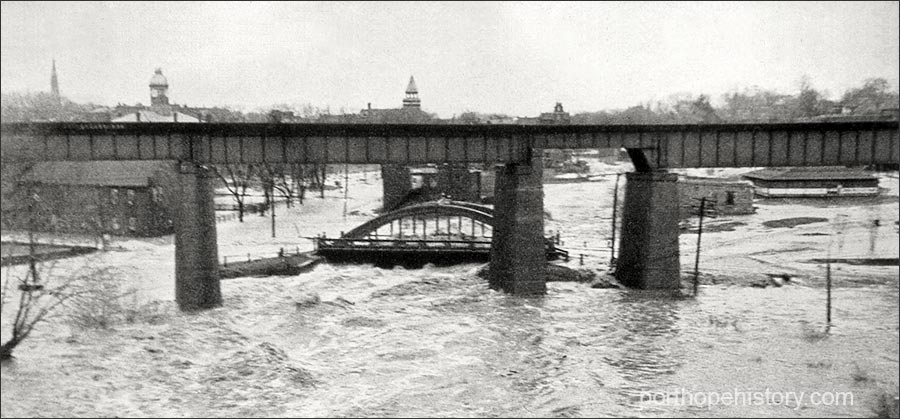
Flood waters at the Peter Street bridge
The plant of the Cosmos Chemical Co, situated next to the Nicholson File, also came in for its share of the flood. The wooden side of the storage sheds next to the river was battered in and water poured into the building. Office employees here were also unable to go to work.
The Ontario Hotel and sheds on Ontario Street were flooded as huge billows pounded over the retaining wall. Occupants were obliged to remain upstairs as water poured out of the office and dining room.
Fire headquarters on Walton street were deluged and firemen toiled throughout the night, rendering service wherever possible. The pumper was taken to a safe distance in order to answer any alarms in one side of the town. The front doors were battered from their hinges and water poured through the building.
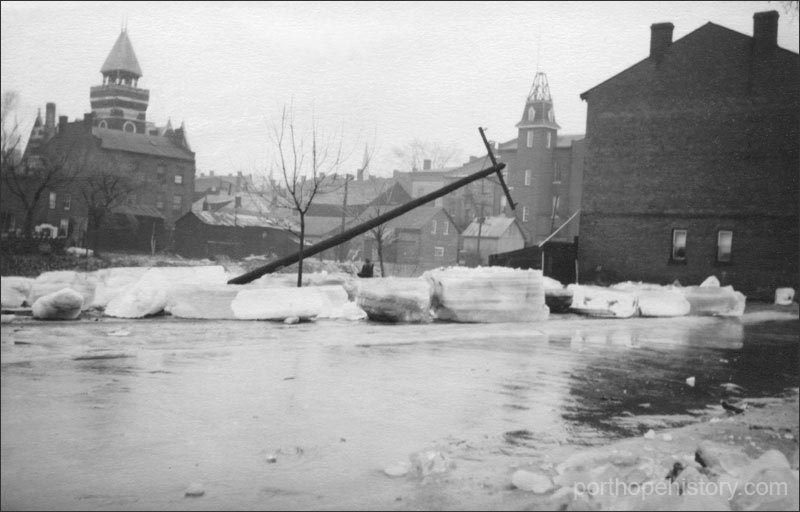
Mill Street 1936
Diagonally across, the British American Service Station, was totally surrounded by huge blocks of ice and rushing waters. A retaining wall here was of little use to stem the tide, although it helped to break the force of the current. Two poles at the foot of the main street were snapped off like kindling wood when rammed by the ice. Wires were left suspended from broken stubs of poles.
Heavy loss was occasioned at Stephenson and Lent's garage on Mill Street. Ice and swirling water carried away the entire corner of the brick building, allowing ice and debris to enter and pile up against stored cars. A double gas pump was smashed from its standard and carried downstream, while another was shifted from its base.
At the rear of Roberts Bros butcher shop, a frame four-car garage was swiped from its foundation and crumpled into a heap. This was at 1:30 when the flood was at its peak. Occupants of the house were: Mr and Mrs T Roberts, Miss D Roberts and R Roberts. They plainly heard the shop and garage go, and then it was thought that the entire dwelling might go. They were imprisoned within and unable to escape.
Stephenson's Bowling Academy, in the heart of the stricken area, escaped comparatively lighty although the damage was severe enough. The cellar was inundated and a gaping hole was knocked in the north end of the building. However the polished alleys did not suffer as water entered at only one corner.
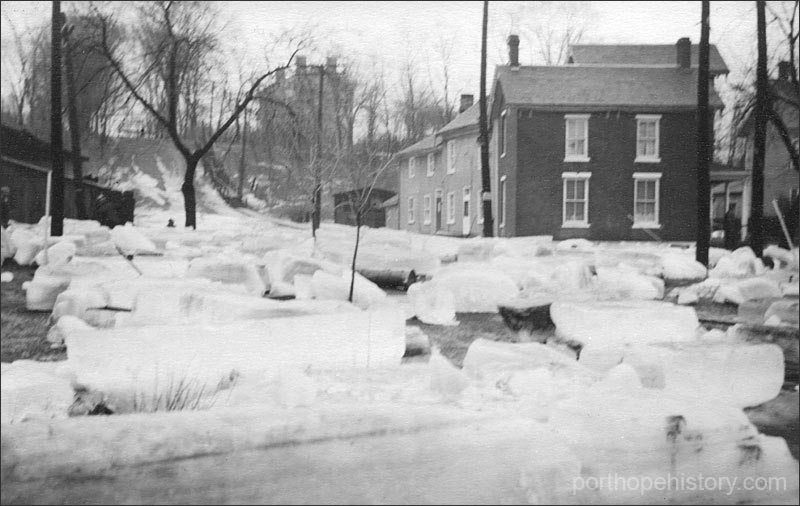
Mill Street South at Dorset Street 1936
Logs and chains from the Nicholson File dam were carried half a mile downstream, one being deposited at the Post Office and another in front of the Town Hall.
A sawlog, twenty feet long and over three feet thick was slammed against the front door of the Registry office.
At least 20 families were trapped in their homes on Walton Street, unable to leave as water, to the depth of four feet, swept by. However, no fear was felt for their safety as they were able to leave when the flood receded. They peered from open windows at the situation.
Fields of ice, with blocks three feet thick and weighing tons were closely packed on Cavan Street, Ontario Street, Mill Street, Queen Street and part of Walton Street. Armed with picks town workmen are engaged in breaking a way through.
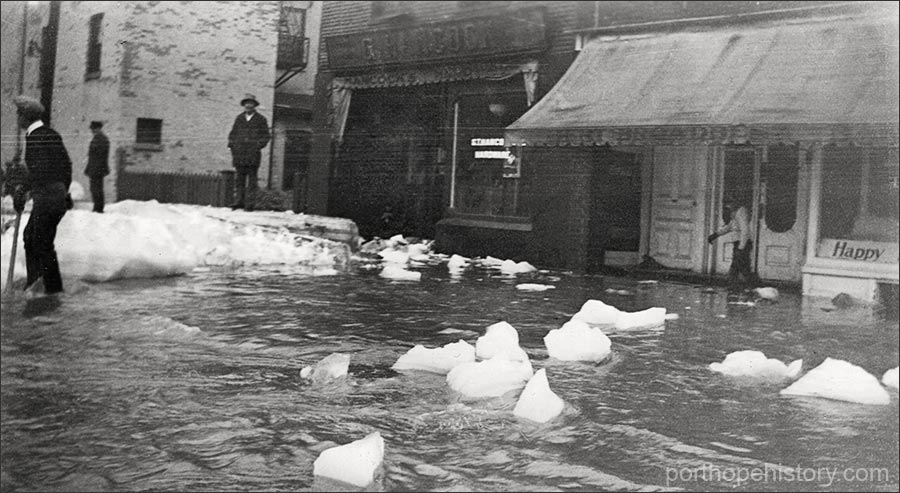
Handcock's Hardware and Broadbent's Bakery on Ontario Street 1936
The last great flood to visit Port Hope was on January 19th, 1929, when a loss estimated at $200,000 was occasioned. At this time three stores on the south side of Walton street were carried away.
Thirty four years ago today another flood visited the town on March 12,1902 and William Douglas lost his life. He was an employee at Barrett's Chop Mill, Ontario Street, and fell off the dam when, in assisting to raise some logs, one twisted and struck him a severe blow. On March 22, 1902 his body was found by three boys - Robert Fox, Will Mercer and Ernest Davis, while grappling in the harbour. He was the father of Mrs W A MacMillan, Princess Street.